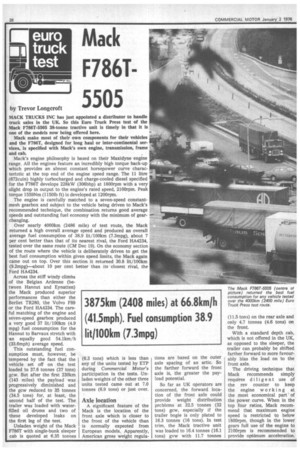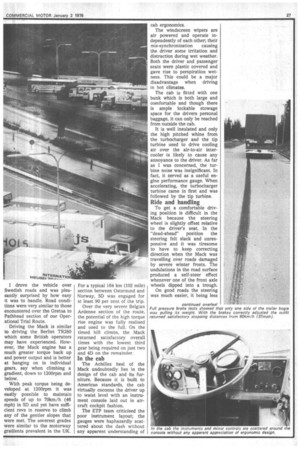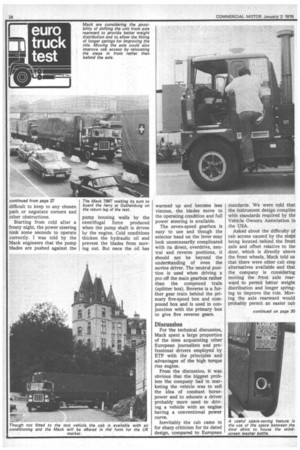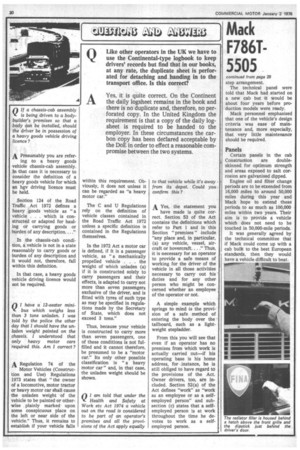euro Mack
Page 28

Page 29

Page 30

Page 32

If you've noticed an error in this article please click here to report it so we can fix it.
Pitr t"t F786T
f
5505
by Trevor Longcroft
MACK TRUCKS INC has just appointed a distributor to handle truck sales in the UK. So this Euro Truck Press test of the Mack F786T-5505 38-tonne tractive unit is timely in that it is one of the models now being offered here.
Mack make most of their own components for their vehicles and the F786T, designed for long haul or inter-continental services, is specified with Mack's own engine, transmission, frame and cab.
Mack's engine philosophy is based on their Maxidyne engine range. All the engines feature an incredibly high torque back-up which provides an almost constant horsepower curve characteristic at the top end of the engine speed range. The 11 litre (672cu1n) highly turbocharged and charge-cooled diesel specified for the F786T develops 228kW (306bhp) at 1800rpm with a very slight drop in output to the engine's rated speed, 2100rpm. Peak torque 1559Nm (11501b ft) is developed at 1200rpm.
The engine is carefully matched to a seven-speed constantmesh gearbox and subject to the vehicle being driven to Mack's recommended technique, the combination returns good average speeds and outstanding fuel economy with the minimum of gearchanging.
Over nearly 4000km (2486 mile) of test route, the Mack returned a high overall average speed and produced an overall average fuel consumption of 38.9 lit/100km (7.3mpg), about 7 per cent better than that of its nearest rival, the Ford HA4234, tested over the same route (CM Dec 19). On the economy section of the route where the vehicle is deliberately driven to get the best fuel consumption within given speed limits, the Mack again came out on top. Over this section it returned 30.8 lit/I0Okm (9.2mpg)—about 10 per cent better than its closest rival, the Ford HA4234.
Across the stiff windy climbs of the Belgian Ardenne (between Hannut and Eynatten) the Mack produced superior performances than either the Berliet TR280, the Volvo F89 or the Ford HA4234. The careful matching of the engine and seven-speed gearbox produced a very good 57 lit/100km (4.9 mpg) fuel consumption for the Hannut to Barvaux stretch with an equally good 54.1km/h (33.6mph) average speed.
This outstanding fuel consumption must, however, be tempered by the fact that the vehicle set off on the test loaded to 37.6 tonnes (37 tons) gcw. But after the first 230km (143 miles) the payload was progressively diminished and the gew reduced to 35 tonnes (34,5 tons) for, at least, the second half of the test. The trailer was loaded with waterfilled oil drums and two of these developed leaks on the first leg of the test.
Unladen weight of the Mack F786T with single-bunk sleeper cab is quoted at 6.35 tonnes (6.3 tons) which is less than any of the units tested by ETP during Commercial Motor's participation in the teats. Unladen weights of the other three units tested came out •at 7.0 tonnes (6.9 tons) or just over.
Axle location
A significant feature of the Mack is the location of the front axle which is closer to the front of •the vehicle than is normally expeoted from European models. Apparently, American gross weight regula tions are based on the outer axle spacing of an artic. So the farther forward the front axle is, the greater the payload potential.
So far as UK operators are concerned, the forward location of the front axle could provide weight distribution problems at 32.5 tonnes (32 tons) gcw, especially if the trailer bogie is only plated to 16.3 tonnes (16 tons). In test trim, the Mack tractive unit was loaded to 16.4 tonnes (16.1 tons) gvw with 11.7 tonnes (11.5 tons) on the rear axle and only 4.7 tonnes (4.6 tons) on the front.
With a standard depth cab, which is not offered in the UK, as opposed to the sleeper, the trailer can probably be shifted farther forward to more favourably bias the load on to the front axle.
The driving technique that Mack recommends simply requires diligent use of the rev counter to keep the •engine working at the most economical part of the power curve. When in the top four ratios, Mack recommend that maximum engine speed is restricted to below 1800rpm, though in the lower gears full use of the engine to 2100rpm is recommended to provide optimum acceleration. I drove the vehicle over Swedish roads and was pleasantly surprised by how easy it was to handle. Road conditions were very similar to those encountered over the Gretna to Pathhead section of our Operational Trial Route.
Driving the Mack is similar to driving the Berliet TR280 which some British operators may have experienced. However, the Mack engine has a much greater torque back up and power output and is better at hanging on in individual gears, say when climbing a gradient, down to 1200rpm and below.
With peak torque being developed at 1200rprn it was easily, possible to maintain speeds of up to 70km/h (46 mph) in 5D and yet have sufficient revs in reserve to climb any of the gentler slopes that were met. The severest grades were similar to the motorway gradients prevalent in the UK. For a typical 164 km (102 mile) section between Ostersund and Norway, 5D was engaged for at least 90 per cent of the trip.
Over the very severe Belgian Ardenne section of the route, the potential of the high torque rise engine was fully realised and used to the full. On the timed hill climbs, the Mack returned satisfactory overall times with the lowest third gear being required on just two and 4D on the remainder.
In the cab
The Achilles heel of the Mack undoubtedly lies in the design of the cab and its furniture. Because it is built to American standards, the cab virtually cocoons the driver up to waist level with an instrument console laid out in aircraft cockpit fashion.
The ETP team criticised the poor instrument layout; the gauges were haphazardly scattered about the dash without any apparent understanding of cab ergonomics.
The windscreen wipers are air powered and operate independently of each other; their mis-synchronisation causing the driver some irritation and distraction during wet weather. Both the driver and passenger seats were plastic covered and gave rise to perspiration wetness. This could be a major disadvantage when driving in hot climates.
The cab is fitted with one bunk which is both large and comfortable and though there is ample lockable stowage space for the drivers personal baggage, it can only be reached from outside the cab.
It is well insulated and only the high pitched whine from the turbocharger and the tip turbine used to drive cooling air over the air-to-air intercooler is likely to cause any annoyance to the driver. As far as I was concerned, the turbine noise was insignificant. In fact, it served as a useful engine performance gauge. When accelerating, the turbocharger turbine came in first and was followed by the tip turbine.
Ride and handling
To get a comfortable driving position is difficult in the Mack because 'the steering wheel is slightly offset relative to the driver's seat. In the "dead-ahead" position the steering felt slack and unresponsive and it was tiresome to have to keep correcting direction when the Mack was travelling over roads damaged by severe winter frosts. The undulations in the road surface produced a self-steer effect whenever one of the front axle Wheels dipped into a trough.
On good roads the steering was much easier, it being less difficult to keep to any chosen path or negotiate corners and other obstructions.
Starting from cold after a frosty night, the power steering took some seconds to operate correctly. I was told by the Mack engineers that the pump blades are pushed against the
The Mack 786T waiting its turn to board the ferry at Gothenburg on the return leg of the test.
pump housing walls by the centrifugal force produced when the pump shaft is driven by the engine. Cold conditions thicken the hydraulic oil and prevent the blades from moving out. But once the oil has warmed up and become less viscous, the blades move to the operating condition and full power steering is available.
The seven-speed gearbox is easy to use and though the selector head on the lever may look unnecessarily complicated with its direct, overdrive, neutral and reverse positions, it should not be beyond the underStanding of even the novice driver. The neutral position is used when driving a pto off the main gearbox rather than the compound train (splitter box). Reverse is a further gear train behind the primary five-speed box and compound box and is used in conjunction with the primary box to give five reverse gears.
Discussion
For the technical discussion, Mack spent a large proportion of the time acquainting other European journalists •and professional drivers employed by ETP with the principles and advantages of the high torque rise engine.
From the discussion, it was obvious that the biggest problem The company had in marketing the vehicle was to sell the idea of constant horsepower and to educate a driver probably more used to driving a vehicle with an engine having a conventional power curve.
Inevitably the cab came in for sharp criticism for its dated design, compared to European standards. We were told that the instrument design complies with standards required by the Vehicle Owners Association in the USA.
Asked about the difficulty of cab access caused by the steps being located behind the front axle and offset relative to the door, which is directly above the front wheels, Mack told us that there were other cab step alternatives available and that the company is considering moving the front axle rearward to permit better weight distribution and longer springing to improve the ride. Moving the axle rearward would probably permit an easier cab step arrangement.
The technical panel were told that Mack had started on a new cab but it would be about four years before production models were ready.
Mack personnel emphasised that one of the vehicle's design criteria was ease of maintenance and, more especially, that very little maintenance should be required.
Panels
Certain panels in the cab Construction are doubleskinned for optimum strength and areas exposed to salt corrosion are galvanised dipped.
Engine oil and filter change periods are to be etxended from 16,000 miles to around 50,000 miles during this year and Mack hope to extend these periods to as much as 100,000 miles within two years. Their aim is to provide a vehicle which does not need to be touched in 50,000-mile periods.
It was generally agreed by the technical committee that if Mack could come up with a cab built to the best European standards, then they would have a vehicle difficult to beat.




































































